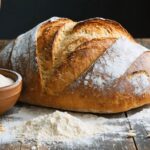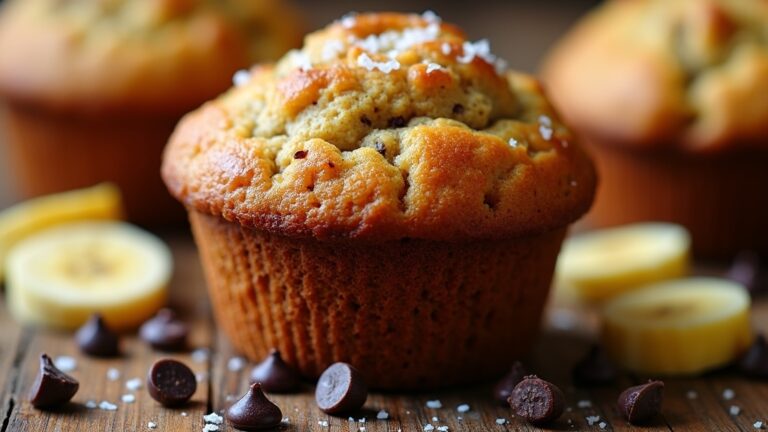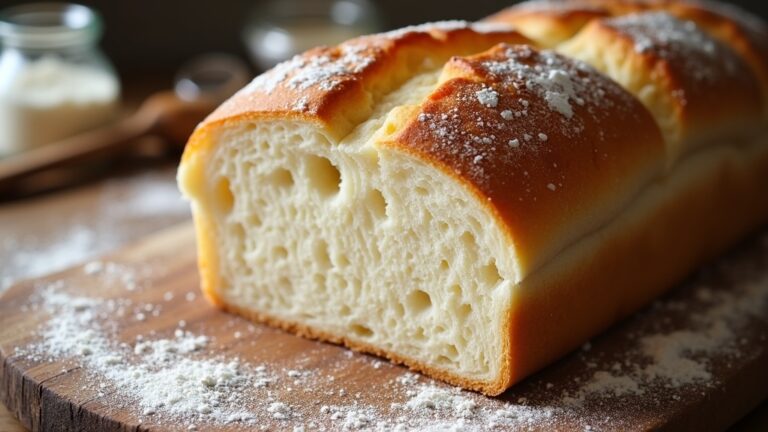Flat Bread Recipe
To make flatbread, mix flour and water to form a dough. Knead it well, then let it rest covered for better flavor. Roll the dough into thin rounds and cook on a hot skillet until golden. Each bite offers a delightful taste of history and versatility. You can enjoy it as a wrap, dip it in sauces, or use it as a base for your favorite toppings. Explore creative ways to enhance your flatbread experience!
Contents
History
Flatbread has a rich history that dates back thousands of years, evolving alongside human civilization. You’ll discover that ancient cultures, from the Egyptians to the Mesopotamians, crafted their own versions, utilizing local grains and cooking methods. As you explore these origins, you’ll see how flatbread became a staple in communal meals, symbolizing sustenance and connection. Each region added its unique twist—think of the naan in India, the pita in the Middle East, or the tortilla in Mexico. These regional variations not only reflect local ingredients but also the diverse culinary traditions that have shaped societies. By embracing this history, you’re not just enjoying flatbread; you’re partaking in a global story of creativity, adaptation, and shared human experience.
Recipe
Flatbread is a versatile and delicious dish that can be enjoyed in various forms across many cultures. It can be served as a side with soups, stews, or curries, or used as a wrap for sandwiches. The beauty of flatbread lies in its simplicity and the ease with which it can be prepared at home. With just a few basic ingredients, you can create a warm and soft flatbread that is perfect for any occasion.
Flatbread is a simple yet versatile dish, perfect for pairing with meals or as a tasty wrap.
The process of making flatbread is straightforward, allowing you to experiment with different flavors and toppings. Whether you prefer a classic recipe or wish to incorporate herbs and spices for an extra kick, this flatbread recipe is a great starting point. Once you master the basic technique, feel free to get creative with toppings such as garlic, olive oil, or even cheese for a delightful twist.
Ingredients:
- 2 cups all-purpose flour
- 1 teaspoon salt
- 1 teaspoon baking powder
- 1 tablespoon olive oil
- 3/4 cup water (adjust as needed)
Cooking Instructions:
In a mixing bowl, combine the flour, salt, and baking powder. Make a well in the center and add the olive oil and water. Mix until a dough forms, then knead for about 5 minutes on a floured surface until smooth. Divide the dough into small balls and roll each ball into a thin round shape. Heat a skillet over medium-high heat and cook each flatbread for 1-2 minutes on each side until they are golden brown and puffed up. Repeat with the remaining dough, keeping the cooked flatbreads warm in a towel.
Extra Tips:
For a softer flatbread, try adding a little yogurt or milk to the dough mixture. You can also experiment with different types of flour, such as whole wheat or spelt, to enhance the flavor and texture. Additionally, if you want to infuse your flatbread with flavors, consider adding herbs like rosemary or thyme into the dough. Finally, make sure your skillet is adequately heated before cooking, as this will help achieve that perfect golden crust while keeping the inside soft and chewy.
Cooking Steps
Now it’s time to bring your flatbread to life with some simple cooking steps. Start by mixing flour and water to form a dough, then knead it thoroughly to develop that perfect texture. Once you’ve rested the dough under a cover, you’ll be ready to roll it out and cook it on a hot surface for that delicious finish.
Step 1. Mix Flour and Water
Start by combining flour and water in a mixing bowl, creating a simple yet essential foundation for your flatbread. Choose your flour type wisely—whole wheat, all-purpose, or even gluten-free options can bring unique flavors and textures. Next, pay attention to water temperature; using warm water, around 110°F, helps activate the flour’s gluten, enhancing the dough’s elasticity. As you pour the water into the flour, watch how they mingle, forming a cohesive mixture. Feel free to adjust the ratios slightly, as the humidity and flour type can affect absorption. Embrace the freedom of experimentation here; your flatbread journey starts with this fundamental blend, setting the stage for deliciousness ahead. Enjoy the process as much as the final product!
Step 2. Knead the Dough Thoroughly
Kneading the dough is where the magic happens, transforming a sticky mixture into a smooth, elastic ball. Achieving the perfect dough consistency is key to a delightful flatbread. Here’s how to knead effectively using simple techniques:
- Push and Fold: Press down on the dough with the heel of your hand, then fold it over itself. Repeat this motion, allowing your body weight to do the work.
- Rotate: After a few folds, turn the dough a quarter turn and continue kneading. This helps develop gluten, giving your bread structure.
- Check Texture: You want the dough to be soft and slightly tacky but not sticking to your hands. If it feels too wet, sprinkle a bit of flour.
Enjoy the freedom of creating your own delicious flatbread!
Step 3. Rest the Dough Covered
After you’ve kneaded the dough to perfection, it’s essential to let it rest, covered, to enhance its flavor and texture. This resting period allows the gluten to relax, leading to a softer, more pliable dough texture that’s easier to work with. You’ll notice the difference in how the dough springs back when you press it; it should feel supple and airy.
Cover the dough with a damp cloth or plastic wrap to prevent it from drying out, allowing it to breathe and develop rich flavors. The resting benefits are undeniable—this step transforms your dough, setting the stage for a delicious flatbread. Embrace this moment; your future bites will thank you for the patience!
Step 4. Roll Out the Dough
With your rested dough ready, it’s time to roll it out into perfectly shaped flatbreads. Embrace the freedom of creativity as you control the dough thickness and transform that lump of dough into a delicious canvas. Here’s how:
- Flour your surface: Lightly dust your work area with flour to prevent sticking and guarantee smooth rolling.
- Use rolling techniques: Start from the center of the dough, applying even pressure as you roll outward. Turn the dough frequently to maintain an even shape.
- Check thickness: Aim for about 1/8 inch thick, adjusting as needed based on your preference.
Enjoy the process and let your flatbreads take shape, ready for the next delicious step!
Step 5. Cook on Hot Surface
Heat a skillet or griddle over medium-high heat until it’s hot enough to sizzle when the dough makes contact. This sizzling sound means you’re ready to embrace the art of griddle cooking. Place your rolled-out flatbread on the surface, and watch it puff up and take on a golden hue. Flip it after about a minute, depending on your heat level, and let the other side achieve that perfect char. Use flatbread techniques like pressing down gently with a spatula for even cooking. The aroma will invite you to take a bite, and the texture will keep you coming back for more. Enjoy the freedom of crafting delicious flatbreads that suit your taste!
Nutritional Guide
Understanding the nutritional profile of flatbread can enhance your culinary experience and health choices. Flatbread offers a range of health benefits, including being a source of complex carbohydrates, which provide sustained energy. Plus, its versatility allows for various dietary variations, making it suitable for different preferences and lifestyles.
| Nutrient | Flatbread (per serving) |
|---|---|
| Calories | 120 |
| Protein | 4g |
| Fiber | 2g |
Final Thoughts
Flatbread not only serves as a delicious accompaniment to meals, but it also supports various dietary needs with its impressive nutritional profile. Beyond its health benefits, flatbread carries a rich cultural significance, connecting you to diverse culinary traditions across the globe.
Here are some serving suggestions to elevate your flatbread experience:
- Wrap it: Use flatbread to envelop fresh veggies and proteins for a quick, satisfying meal.
- Dip it: Pair it with hummus, tzatziki, or your favorite dip for a delightful snack.
- Toast it: Lightly toast flatbread and top it with olive oil, herbs, and cheese for a simple appetizer.
Embrace the freedom of creativity in your kitchen and enjoy the versatile world of flatbread!
Frequently Asked Questions
Can I Use Gluten-Free Flour for Flatbread?
Absolutely, you can use gluten-free flour for flatbread! Explore various flour alternatives like almond or coconut flour. These gluten-free options provide unique flavors and textures, letting you enjoy delicious, wholesome flatbreads without compromising your dietary choices.
How Long Does Flatbread Stay Fresh?
Flatbread freshness typically lasts about three days at room temperature, but you can extend its storage duration by refrigerating it. Just remember to wrap it well to keep it soft and tasty for longer enjoyment!
What’s the Best Way to Store Flatbread?
To keep your flatbread fresh, use airtight storage containers. This minimizes humidity exposure, preventing sogginess. Consider wrapping it in parchment paper before placing it inside, allowing you to enjoy that delightful texture longer, freely!
Can I Freeze Flatbread?
If you’re looking to embrace the chill of preservation, you can absolutely freeze flatbread! Just use proper freezing techniques, wrap it well, and enjoy convenient flatbread storage for future meals without losing that delightful freshness.
What Toppings Pair Well With Flatbread?
When you’re topping your flatbread, consider herb toppings like basil, a variety of cheese blends, savory meat options, fresh veggie spreads, flavorful sauce pairings, and seasonal toppings. Each choice enhances your culinary freedom!
Conclusion
As you savor that warm, fluffy flatbread, remember the rich history that wraps around each bite. It’s not just a meal; it’s a journey through time, where ancient traditions meet your modern kitchen. While store-bought options might tempt you with convenience, nothing compares to the satisfaction of crafting your own. So, roll up your sleeves and embrace the art of flatbread-making—it’s a simple pleasure that transforms ordinary meals into extraordinary experiences. Enjoy every delicious moment!








